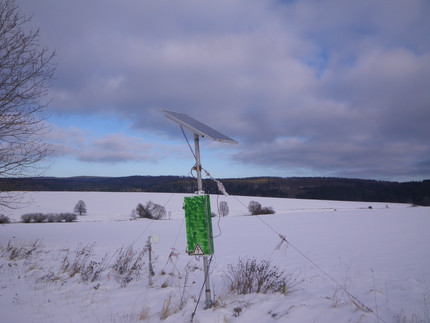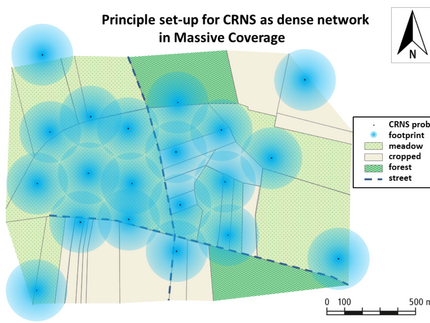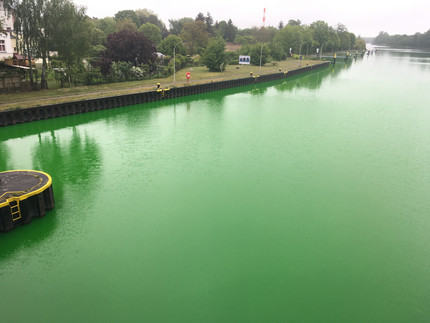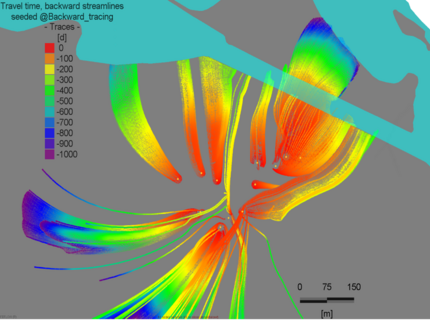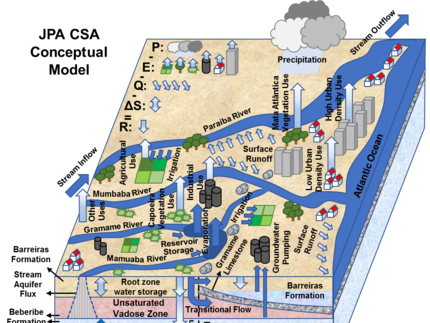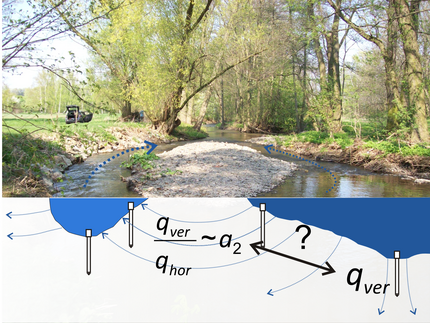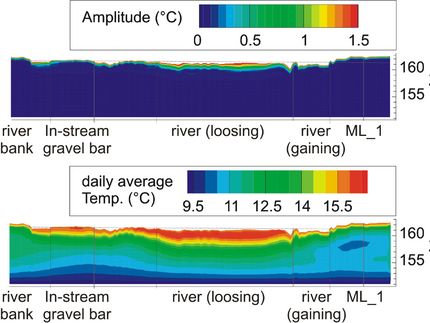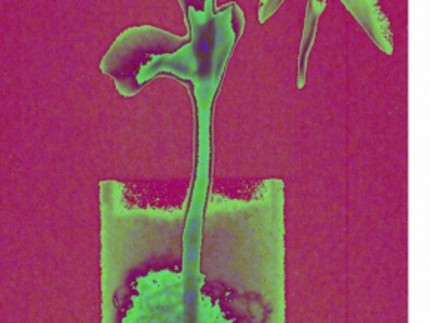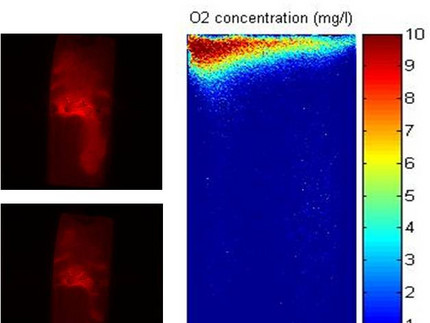Completed projects
Cosmic Sense, Module Groundwater
Project description:
Sustainable management of groundwater resources requires detailed knowledge on the amount of recharge. Soil moisture is the relevant storage that controls the movement of water in the unsaturated zone. The scales relevant for groundwater resources are much larger than the scales covered by conventional in-situ soil moisture measurement techniques. Cosmic-ray neutron sensing (CRNS) measures intermediate scale soil moisture with a support volume of tens of hectares and tens of centimeters and thus can contribute to groundwater recharge estimates on the field and small catchment scale. In this context, also the snow water equivalent and its contribution to groundwater recharge can be measured by CRNS.
The aim of this project is to develop a stand-alone method to estimate groundwater recharge from CRNS soil moisture and snow on field scale and above. It will be explored, how this root zone soil moisture can be related to downward fluxes of water also below the vertical footprint of the probe.
For this, dedicated field experiments are conducted for snow and soil water content measurements. As CRNS covers the upper part of the root zone, it will be extended by soil hydrological modelling. The data will be complemented by data from partners of the COSMIC SENSE team. Finally, a numerical model of groundwater levels and horizontal flow to surface water will be set up and tested based on the measurements obtained.
Contact:
Cosmic Sense, Module Massive Coverage
Project description:
As part of the DFG research group "Cosmic Sense", the project "Massive Coverage" establishes dense networks of so-called Cosmic Ray Neutron Sensors (CRNS). For this purpose, two more intensive monitoring campaigns (Fendt / Oberbayern, Wüstebach / Eifel) and longer-term monitoring campaigns (Schäfertal / Harz, Marquardt / Brandenburg) are conducted. The goal is, on the one hand, the comprehensive recording of soil moisture dynamics within the root zone of small catchments (approximately one square kilometre). On the other hand, the intensive monitoring allows the generation of high resolution soil moisture maps beyond the actual sensor footprint by employing inversion and downscaling methods.
Contact:
More information under:
https://www.uni-potsdam.de/en/cosmicsense/research/massive-coverage-mc
Surface water - groundwater interaction on federal waterways II
Project description:
Interaction processes between surface water (SAW) and groundwater (GW) represent an essential component in the overall water balance and thus also in the material balance in the Havel region. During the infiltration of river water into the aquifer a multitude of physical, chemical and biological processes take place. The infiltration of SAW into the GW depends on the hydraulic conditions, the hydrogeological aquifer properties and the structural structure and degree of colmatisation of the river beds. Hydraulic engineering interventions that influence the composition of the river bed can significantly change the interaction between SAW and GW as well as the associated water and material flows. At the research site Brandenburg, large-scale tracer experiments in combination with numerical modeling will be used to identify and quantify hydraulic engineering interventions with regard to the expected effects on water and material flows between SAW and GW.
Contact:
Surface water - groundwater interaction on federal waterways I
Project description:
This research project mainly is about the effects of reconstruction measures of river banks and bottom at a river section that is the contributing area of abstraction of groundwater via river bank filtration. After the reconstruction, the hydraulic conductivity of the riverbed and river banks seems to have increased going along with a larger infiltration rate from the river to the groundwater system and further changed the groundwater flow field as well as the temperature distribution along the flow path. We have set up a three-dimensional groundwater flow and heat transport model to simulate the change. By comparing two scenarios with/without reconstruction, we could quantify the increase of the infiltration rate of the riverbed and the change of the contribution ratio between infiltrated surface water and genuine groundwater to the pumping wells of the water works. Stable isotope and other water quality data were also included in the research to further characterize the redox zonation of the flow field and further analyse the influence of the hydraulic changes on the groundwater quality.
Contact:
Weishi Wang
Kooperationspartner:
Hermann Lensing, Daniel Strasser (Bundesanstalt für Wasserbau, Karlsruhe)
Carsten Zühlke (Stadtwerke Potsdam)
Groundwater recharge estimate in a Brazilian sedimentary coastal region - Combining remote sensing, CRNS soil moisture data and hydro(geo)logical modelling
Project description:
The use of remote sensing and reanalysis data have been playing an important role in providing distributed global and regional information for resources management. However, the contributions of this type of data for quantifying groundwater recharge are still incipient because almost all current data available from satellite images can only detect patterns and spatial processes that are related to resources on and above the Earth's surface. Based on this statement, some studies have integrated remote sensing products and terrestrial data to estimate regional values of groundwater recharge from the water balance equation. Nevertheless, the studies using this approach were mostly applied in continental and semi-arid regions with clear-sky conditions, mainly because of the difficulties in obtaining continuous evapotranspiration data for cloudy-sky conditions. Moreover, most of the aforementioned studies used only precipitation, evapotranspiration, and surface runoff variables, but neglected the currently available soil moisture data. Considering the limitations of the previous studies, our aim is to estimate the spatial distribution of groundwater recharge in a complex sedimentary area using remote sensing, reanalysis and ground-based data. The Gramame basin and downstream right-bank of Paraíba basin (1,032 km2) is the selected area for this study, which comprises a tropical wet and cloudy-sky region located in North-east Brazil. The methodology used to estimate the groundwater recharge is based on the residual of the following terms considered in the water balance: precipitation, evapotranspiration, surface runoff, and soil water storage. Precipitation data is derived from the Integrated Multi-satelittE for GPM (IMERG) product at 0.1° x 0.1° (spatial) and half-hour (temporal) resolutions. Evapotranspiration is obtained by a modified MOD16 algorithm to fit more regional information (land use from MapBiomas project), modify some parametrisations to generate a new product for all sky conditions, and change the reanalysis meteorological forcing dataset. Surface runoff is estimated through the Natural Resources Conservation Service - Runoff Curve Number (NRCS-CN) method based on IMERG and MapBiomas data. Finally, the soil water storage in the root zone is obtained from a Soil Moisture Active Passive (SMAP) satellite product. Downscaling and bias correction are also applied to enhance the performance of these remotely sensed products. For the validation, groundwater recharge is also calculated from a monitoring well network through the Water Table Fluctuation (WTF) method, as well as the 1-D cumulative vertical flux is modelled from intermediary-scaled Cosmic-Ray Neutron Sensing (CRNS) data within the root zone.
Contact:
Luís Barbosa
Research on river groundwater interaction
Water flow and heat transport modelling at the interface between river and aquifer
Project description:
Surface waters (SFW) and groundwater (GW) are the interconnected parts of stream catchments. They are coupled by variable water, solute and heat exchange processes through streambed sediments affecting water discharges as well as water quality. For example, the microbial activity in the transition zone between rivers and groundwater, where up to 97 % of the entire stream respiration occurred, is basically controlled by the availability of oxygen, carbon and the temperature conditions. The goal of this research project will be to analyse and quantify the spatial and temporal variability of SFW-GW fluxes and heat exchange and, in turn, to investigate how these processes affect subsurface temperature condition.
We develop multiple methods, using the natural temperature signal (heat as a natural tracer), to determine subsurface water flow direction and to calculate vertical water fluxes in riverbed sediments based on measured temperature time series observed at multiple depths.
We simulate the spatial and temporal variability of river groundwater exchange, hyporheic flow and temperature pattern, to gain better insights on hydrological and thermal controls dominating the behaviour of an entire river reach. We furthermore use the fully integrated numerical modelling approach to investigate the benefits of temperature in model calibration and parametrisation.
Contact:
Financial support:
Research School-GeoSim und TERENO (Terrestrial Environmental Observatories).
Period:
2011 - 2015
Cooperation partner:
Helmholtz-Zentrum für Umweltforschung UFZ, Department "Hydrogeologie" (Leipzig, Germany)
Visualization of root water uptake processes using the novel combination of magnet resonance imaging and neutron tomography
Project description:
Die Rhizosphäre, also der Boden, der sich in unmittelbarer Umgebung von Pflanzenwurzeln befindet, reguliert die Wasserflüsse zu den Wurzeln. Obwohl die meisten Modelle gleiche Bodeneigenschaften von durchwurzeltem und von undurchwurzeltem Boden annehmen, weisen mehrere Versuchsergebnisse daraufhin, dass sich die chemischen, physikalischen und hydraulischen Eigenschaften voneinander unterscheiden. Auf Grund von technischen Schwierigkeiten ist bisher wenig bezüglich der hydraulischen Eigenschaften der Rhizosphäre und des Einflusses von Wurzelexudaten mit hohem Molekulargewicht (“Mucilage”) auf die lokale Bodenwasserretentionskurve bekannt. Neuartige Bildgebungsmethoden überwinden die bisherigen technischen Limitierungen indem sie räumlich und zeitlich hochaufgelöste Daten hinsichtlich Bodenheterogenitäten und Bodenwasserverteilungen produzieren. Auf diese Weise kann die Wurzelstruktur und die Bodenwasserverteilung in Bodenproben mit Pflanzen in situ und zerstörungsfrei untersucht werden.
Im Rahmen dieses Projekts werden wir zum ersten Mal die beiden Bildgebungsmethoden Magnetic Resonance Imaging (MRI) und Neutronentomographie (NT) kombinieren, um die zeitliche und räumliche Dynamik von wurzelexudiertem Mucilage zu untersuchen. Auf Grundlage dieser Ergebnisse werden wir den Einfluss dieser Exudate auf die Bodenwasserverteilung und auf die Wurzelwasseraufnahmedynamiken bestimmen.
Contact:
Integrated water resource management in agricultural landscapes
Project description:
Die Fortschritte der letzten Jahrzehnte im Bereich der Informatik und im Verständnis hydrologischer Prozesse führten zu einer wachsenden Zahl von Modellierungsmöglichkeiten im Zusammenhang mit der Simulation von komplexen Wasserressourcen-Systemen. Oft werden hierbei auch unterschiedliche Darstellungen eines bestimmten hydrologischen Prozesses berücksichtigt. Die erhöhte Komplexität der Modelle führte jedoch auch zu einem wachsenden Datenbedarf, zum Beispiel zur Durchführung von Parameterrückschlüssen, oder von Modellverifizierungen. Diesem Bedarf sollte mit einer vernünftigen, zielorientierten und kosteneffizienten Art der Datenerhebung begegnet werden. Angesichts der enormen Vielfalt neuartiger Untersuchungs- und Datenerfassungsmethoden ist die Entwicklung von optimierten Monitoring-Netzwerken und Erkundungsschemata notwendig.
Das Hauptthema meiner Forschung ist es, die Eignung verschiedener hydrologischer Modelle für landwirtschaftliche Fragestellungen des Wassermanagements, z.B. Landnutzung und Bewässerungseffizienz, zu beurteilen. Hierfür betrachten wir Monitoring- und Modellieraktivitäten gemeinsam als Bestandteile standortspezifisch ausgerichteter Forschung innerhalb eines Lernprozesses. Unsicherheits- und Sensitivitätsanalysen werden als unerlässliches Werkzeug für die Bewertung des Models berücksichtigt, um die Verteilung der Ressourcen zu optimieren.
Contact:
Dr. Gabriele Baroni
High-resolution imaging in aggregated soils: Dynamics of oxygen, pH and water content induced interfaces
Project description:
In meinem Projekt geht es um die Visualisierung der Sauerstoff- und Wasserverteilung im Boden. Gelöster Sauerstoff ist der primäre Elektronenakzeptor im Boden. Seine Konzentration unterliegt Reaktionen der Sauerstoffzerrung. Unser Ziel ist es, Sauerstoff-Transitionszonen in Böden innerhalb eines Bereichs von bis zu 10cm sichtbar zu machen und zu quantifizieren. Die Entstehung dieser Zonen ist auf das Zusammenwirken von unterschiedlichen Einflussparametern (u.a. Bodenstruktur, Wasserfluss, Sauerstofftransport und Sauerstoffzerrreaktionen) zurückzuführen. Einerseits werden Sauerstofftransitionszonen bei höherer Wassersättigung als Ergebnis metabolischer Aktivitäten entstehen. Andererseits werden die Sauerstofftransitionszonen auch diese Aktivitäten limitieren oder erhöhen. Eine Grundvoraussetzung um die Verteilung von gelöstem Sauerstoff zu quantifizieren, ist die Kenntnis der Wassergehaltsverteilung, die einen wichtigen Einflussfaktor für den Ablauf biogeochemischer Bodenprozesse bildet.
Die Methode basiert auf einer Kombination kürzlich entwickelter Bildgebungsansätze, z.B. die Möglichkeit gelöste Sauerstoffkonzentrationen durch Fluoreszenz von spezifischen, gelösten lumineszierenden Molekülen zu ermitteln, die bei Anregung mit UV-Licht als Sauerstoffsonden agieren. Das Fluoreszenzlicht kann mit Hilfe einer Kamera detektiert werden, wodurch auch die Visualisierung schneller Änderungen möglich ist. Ich wende diese Methode für gesättigte bis ungesättigte Bedingungen an. Zur Quantifizierung des Bodenwassergehalts verwende ich neben Fluoreszenz- auch Neutronen-Bildgebungsverfahren.
Contact:
Dr. Nicole Rudolph-Mohr
Cooperation partners:
- Prof. J. Bachmann (Universität Hannover) & G. Mühl (Leibnitz-Institut Großbeeren)
- Prof. S. Banwart & Dr. J. Bridge (University of Sheffield)
- Dr. T. Baumann & Prof. R. Niessner (Technische Universität München)
- Dr. A. Carminati (Helmholtz Zentrum für Umweltforschung Leipzig)
- Dr. S. Kolb & Prof. H. Drake (Universität Bayreuth)
- Dr. E. Lehmann (PSI, Schweiz) & Dr. N. Kardjilov (Helmholtz-Zentrum Berlin)
- Dr. S. Nagl (Universität Leipzig) & Prof. P. Wessig (Universität Potsdam)
Oxygen dynamics at the capillary fringe
PhD student: M.Sc. Sandip Chaudhary
Supervisor: Prof. Sascha Oswald
Dynamic interaction of flow and transport between the transition zone of saturated and unsaturated zone i.e. capillary fringe is not well understood. Investigating the spatio-temporal dynamics of Interaction between saturated and unsaturated zone would lead to better understanding of the fate of contaminants in groundwater. The aim of the research is to observe and quantify mass transfer dynamics at the capillary fringe.
Non-invasive imaging technique is applied to visualize 2-D distribution of oxygen at the interface and observe the mass transfer dynamics between the unsaturated to saturated zone. Additionally, Transport modelling (conservative and reactive) of mass transfer of oxygen via capillary fringe using multicomponent numerical code for variably saturated porous media will be carried out based on the Physical model.
Founded by Graduate Research School-GeoSim
- Running-period: January 2014 – December 2015
Integrale Messung des Bodenwassergehalts mittels kosmischer Neutronenstrahlung - Interpretation der erhobenen Daten
PhD student: M.Sc. Carlos Andrés Rivera Villareyes
Supervisor: Prof. Sascha Oswald
Der Bodenwassergehalt spielt eine entscheidende Rolle für die Steuerung von Wasser- und Wärmeflüssen zwischen Boden, Vegetation und Atmosphäre. Neben Auswirkungen auf das regionale Klima beeinflusst der spezifische Wassergehalt auch weitere Prozesse, z.B. Transport gelöster Stoffe, biochemische Transformationen von Nährstoffen, oder die Grundwasserneubildung. In den letzten Jahrzehnten konnte durch die Entwicklung verschiedener neuer Sensoren im Bereich der kleinskaligen Bodenfeuchtebestimmung erhebliche Fortschritte erzielt werden. Hingegen kämpfen großskalige Methoden wie die Fernerkundung noch immer mit einigen Schwierigkeiten wie der Durchdringungstiefe, der Messung von Bodeneis, oder der Sensitivität unterschiedlicher Oberflächenrauhigkeiten. Bis heute konnten trotz der großen Bedeutung von räumlich begrenzten Wasserfeuchtedaten für die Modellierung von Wassereinzugsgebieten, keine geeigneten Methoden zur mittelskaligen Wassergehalts-Messung entwickelt werden.
In meiner Doktorarbeit beschäftige ich mich mit einer neuartigen nicht-invasiven Technik, deren Funktionsweise auf der Grundlage des Abhängigkeitsverhältnisses von niederenergetischer kosmischer Neutronenstrahlintensität über der Erdoberfläche und dem Wasserstoffgehalt des Bodens beruht. Auf diese Weise können integrale Langzeitmessungen des Wassergehalts in der Größenordnung einzelner Einzugsgebiete an verschiedenen Orten in Deutschland durchgeführt werden. Die Messwerte werden durch ein Sensornetzwerk (TDR und FDR-Sonden) verifiziert. Diese verifizierten Daten werden dann verwendet um hydrologische Modelle zu kalibrieren. Im letzten Schritt werden die Messwerte genutzt um die Bewässerungseffizienz an unterschiedlichen Standorten zu bewerten und um Bodenwasserflüsse zu quantifizieren.
Financial support: BMBF (Bundesministerium für Bildung und Forschung)
- Period: August 2010 - Juli 2013
- Part of IPSWaT (International Postgraduate Studies in Water Technologies)
Cooperation partner:
- Universität von Piura (Peru)
Transportverhalten künstlicher Aktivkohle-Eisen-Nanopartikel zur Sanierung von chlororganisch belasteten Grundwasserströmen
PhD student: Dipl.-Umweltwiss. Jan Busch
Supervisor: Prof. Sascha Oswald
Grundwasser stellt eine wichtige Ressource dar, die es zu schützen gilt. Auf Industriestandorten innerhalb und außerhalb der Städte wurden seit Beginn der Industrialisierung Boden und Grundwasser mit verschiedensten Schadstoffen kontaminiert. Ein moderner Ansatz zur Sanierung von chlororganisch belastetem Grundwasser ist der Einsatz von elementaren Eisen in granulierter Form als reaktive Wand oder in mikro- und nanoskaliger Größe als injizierbare Lösung. Unterhalb von versiegelten Flächen ist der Einsatz von Eisen durch mangelnde Mobilität nicht erfolgversprechend. An dieser Stelle setzt das im Projekt Fe-Nanosit entwickelte Material Carbo-Iron an. Carbo-Iron besteht aus aktivkohlebasierten Partikeln, deren Oberfläche und Porenraum mit Eisennanopartikeln beschichtet ist.
In meinem Promotionsprojekt beschäftige ich mich mit dem Transportverhalten dieser Partikel. Es soll mit Hilfe von Säulenversuchen und Laboraquiferen untersucht werden, welche Bedingungen Einfluss auf das Transportverhalten der Partikel haben. Parallel dazu soll durch magnetresonanztomographische Methoden (MRT) der Transport und das Agglomerationsverhalten im Boden beobachtet werden. Eine weitere vielversprechende Methode ist die Nutzung von Synchrotronstrahlung zur Beobachtung der Oberflächenanhaftung und der Verteilung der Partikel im Porenraum eines porösen Mediums. Mit Hilfe der so gewonnenen Informationen soll das Transportverhalten der Partikel optimiert werden und an die jeweiligen Gegebenheiten und Anforderungen angepasst werden können.
Financial support:BMBF (Bundesministerium für Bildung und Forschung)
- Period: Oktober 2009 - September 2012
Cooperation partner:

